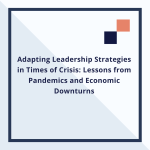In a world marked by uncertainty, crises such as global pandemics and economic downturns have become inevitable disruptions that challenge leaders across industries. The COVID-19 pandemic was a stark reminder of how quickly circumstances can change, pushing leaders to rethink strategies and adapt in real-time. While the nature of crises may differ, their impact on businesses and teams remains significant, highlighting the need for resilient, flexible, and proactive leadership.
This article explores key strategies that leaders can adopt to steer their organizations through crises, ensuring not only survival but also potential growth.
Table of contents [Show]
1. Embrace Agility in Decision-Making
In times of crisis, the speed of decision-making becomes a critical factor. Leaders who are able to make quick, informed decisions are better positioned to navigate uncertainty. Agility means being ready to pivot plans when necessary and not sticking rigidly to old strategies.
To embrace agility:
- Adopt a flexible mindset: Recognize that crises may require deviation from the norm. Leaders should be willing to modify business strategies, restructure teams, or shift focus based on real-time data and emerging trends.
- Empower decentralized decision-making: Encourage leaders at all levels to make decisions without waiting for top-down directives. This speeds up response times and enables quicker adaptation to changing conditions.
2. Prioritize Clear and Transparent Communication
In times of uncertainty, fear and confusion can quickly spread within an organization. Strong communication from leadership is essential to keep employees informed, engaged, and aligned.
Effective communication strategies include:
- Maintain transparency: Share both the challenges and the steps being taken to address them. Transparency builds trust and helps employees feel more secure even when facing difficult circumstances.
- Provide regular updates: Create a consistent cadence for communication, whether it’s through weekly updates, town hall meetings, or internal newsletters. Regular communication helps keep everyone on the same page.
- Listen to feedback: Foster a culture where employees feel safe expressing their concerns and providing feedback. Open channels of communication ensure that leadership stays aware of what’s happening on the ground.
3. Focus on Employee Well-Being
A crisis can take a toll not only on a company’s bottom line but also on the mental and emotional well-being of its employees. Leaders need to prioritize the health and safety of their teams while ensuring they remain productive and motivated.
Ways to support employee well-being:
- Implement flexible work arrangements: Whether it’s offering remote work, adjusting schedules, or providing additional leave, flexibility can help employees manage their personal and professional responsibilities during a crisis.
- Provide mental health resources: Offering access to mental health support services, counseling, or wellness programs can significantly improve employee morale and resilience.
- Recognize individual challenges: Understand that crises affect people differently. Being empathetic to the unique circumstances of each team member helps foster a supportive work environment.
4. Leverage Technology to Adapt
Technological innovation has been a lifeline for many organizations during crises like the COVID-19 pandemic. From enabling remote work to streamlining operations, technology plays a crucial role in helping businesses maintain continuity.
Leaders should:
- Invest in digital transformation: Accelerate the adoption of technology to optimize remote work, digital collaboration, and automation of routine tasks.
- Use data-driven decision-making: Leverage data analytics to assess the business environment, customer behavior, and operational performance in real time. This enables leaders to make informed, adaptive decisions during volatile periods.
- Explore new business models: Crises can open the door to innovation. Leaders should be open to experimenting with new business models, whether it’s expanding into e-commerce, offering virtual services, or diversifying revenue streams.
5. Reevaluate Financial Strategies
Economic crises, in particular, can strain resources and impact financial stability. Leaders need to implement smart financial strategies to weather the storm and emerge stronger.
Key financial strategies include:
- Cut costs strategically: Rather than slashing budgets across the board, identify areas where cost savings can be achieved without sacrificing long-term growth. This might mean renegotiating contracts, optimizing supply chains, or temporarily scaling back non-essential projects.
- Build cash reserves: In times of economic uncertainty, liquidity is key. Leaders should focus on building and maintaining cash reserves to provide a buffer against future shocks.
- Explore alternative revenue streams: Look for new opportunities to generate income, whether by offering new products or services or tapping into different customer segments.
6. Lead with Empathy and Resilience
During a crisis, the emotional intelligence of a leader can make all the difference. Leading with empathy helps to create a culture of trust and collaboration, while resilience ensures that the organization can navigate through adversity.
Ways to lead with empathy and resilience:
- Be visible and accessible: Even in times of crisis, leaders need to be present and accessible to their teams. This helps employees feel connected and supported.
- Stay optimistic but realistic: It’s important to strike a balance between optimism and realism. Leaders should inspire confidence without downplaying the seriousness of the situation.
- Learn from failure: Not every decision made in a crisis will lead to immediate success. Leaders should be open to learning from mistakes and iterating on strategies to improve outcomes.
7. Plan for the Future, Not Just the Present
One of the biggest mistakes leaders can make during a crisis is focusing solely on short-term survival. While immediate actions are necessary, leaders also need to think about long-term recovery and growth.
Long-term strategies include:
- Develop contingency plans: Ensure that the organization has contingency plans in place for future crises. This includes stress-testing business models, building flexible supply chains, and diversifying revenue streams.
- Invest in leadership development: Crises can reveal gaps in leadership capabilities. Invest in leadership development programs to prepare your team for future challenges.
- Innovate continuously: Use the lessons learned during a crisis to drive continuous innovation. Encourage a culture of creativity and experimentation, even in difficult times.
Conclusion
Crises are an inevitable part of the business landscape, but with the right leadership strategies, organizations can navigate through uncertainty and come out stronger on the other side. By embracing agility, prioritizing communication, supporting employee well-being, leveraging technology, and maintaining a focus on long-term growth, leaders can not only survive crises but also position their organizations for future success.
As we continue to face global challenges, the ability to adapt will remain a hallmark of effective leadership. Leaders who are resilient, empathetic, and forward-thinking will be best equipped to lead their teams through turbulent times and emerge victorious.






